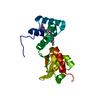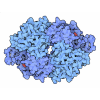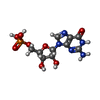[English] 日本語
 Yorodumi
Yorodumi- PDB-8pkz: NMR solution structure of PilF-GSPIIB in the c-di-GMP bound state -
+ Open data
Open data
- Basic information
Basic information
| Entry | Database: PDB / ID: 8pkz | ||||||
|---|---|---|---|---|---|---|---|
| Title | NMR solution structure of PilF-GSPIIB in the c-di-GMP bound state | ||||||
 Components Components | ATP-binding motif-containing protein pilF | ||||||
 Keywords Keywords | MOTOR PROTEIN / PilT class / NMR-structure / ligand binding / GSPII | ||||||
| Function / homology |  Function and homology information Function and homology information | ||||||
| Biological species |   Thermus thermophilus HB27 (bacteria) Thermus thermophilus HB27 (bacteria) | ||||||
| Method | SOLUTION NMR / distance geometry / simulated annealing / torsion angle dynamics | ||||||
 Authors Authors | Neissner, K. / Woehnert, J. | ||||||
| Funding support |  Germany, 1items Germany, 1items
| ||||||
 Citation Citation |  Journal: To Be Published Journal: To Be PublishedTitle: NMR solution structure of GSPIIB of Thermus thermophilus in the c-di-GMP bound state Authors: Neissner, K. / Woehnert, J. | ||||||
| History |
|
- Structure visualization
Structure visualization
| Structure viewer | Molecule:  Molmil Molmil Jmol/JSmol Jmol/JSmol |
|---|
- Downloads & links
Downloads & links
- Download
Download
| PDBx/mmCIF format |  8pkz.cif.gz 8pkz.cif.gz | 1.1 MB | Display |  PDBx/mmCIF format PDBx/mmCIF format |
|---|---|---|---|---|
| PDB format |  pdb8pkz.ent.gz pdb8pkz.ent.gz | 910.9 KB | Display |  PDB format PDB format |
| PDBx/mmJSON format |  8pkz.json.gz 8pkz.json.gz | Tree view |  PDBx/mmJSON format PDBx/mmJSON format | |
| Others |  Other downloads Other downloads |
-Validation report
| Summary document |  8pkz_validation.pdf.gz 8pkz_validation.pdf.gz | 679.4 KB | Display |  wwPDB validaton report wwPDB validaton report |
|---|---|---|---|---|
| Full document |  8pkz_full_validation.pdf.gz 8pkz_full_validation.pdf.gz | 868.2 KB | Display | |
| Data in XML |  8pkz_validation.xml.gz 8pkz_validation.xml.gz | 75.9 KB | Display | |
| Data in CIF |  8pkz_validation.cif.gz 8pkz_validation.cif.gz | 83.8 KB | Display | |
| Arichive directory |  https://data.pdbj.org/pub/pdb/validation_reports/pk/8pkz https://data.pdbj.org/pub/pdb/validation_reports/pk/8pkz ftp://data.pdbj.org/pub/pdb/validation_reports/pk/8pkz ftp://data.pdbj.org/pub/pdb/validation_reports/pk/8pkz | HTTPS FTP |
-Related structure data
| Similar structure data | Similarity search - Function & homology  F&H Search F&H Search |
|---|---|
| Other databases |
- Links
Links
- Assembly
Assembly
| Deposited unit | 
| |||||||||
|---|---|---|---|---|---|---|---|---|---|---|
| 1 |
| |||||||||
| NMR ensembles |
|
- Components
Components
| #1: Protein | Mass: 16269.562 Da / Num. of mol.: 1 Source method: isolated from a genetically manipulated source Details: Each molecule consists of the protein bound to c-di-GMP (residues 147-148). Source: (gene. exp.)   Thermus thermophilus HB27 (bacteria) / Gene: pilF, TT_C1622 / Production host: Thermus thermophilus HB27 (bacteria) / Gene: pilF, TT_C1622 / Production host:  | ||
|---|---|---|---|
| #2: Chemical | | Has ligand of interest | Y | |
-Experimental details
-Experiment
| Experiment | Method: SOLUTION NMR | ||||||||||||||||||||||||||||||||||||||||||||||||||||||||||||||||||||||||||||||||||||||||||||||||||||||||||||||||||||||||||||||||||||||||||||||||||||||||||||||||||||||||||||||||||||||||||||||||||||||||||||
|---|---|---|---|---|---|---|---|---|---|---|---|---|---|---|---|---|---|---|---|---|---|---|---|---|---|---|---|---|---|---|---|---|---|---|---|---|---|---|---|---|---|---|---|---|---|---|---|---|---|---|---|---|---|---|---|---|---|---|---|---|---|---|---|---|---|---|---|---|---|---|---|---|---|---|---|---|---|---|---|---|---|---|---|---|---|---|---|---|---|---|---|---|---|---|---|---|---|---|---|---|---|---|---|---|---|---|---|---|---|---|---|---|---|---|---|---|---|---|---|---|---|---|---|---|---|---|---|---|---|---|---|---|---|---|---|---|---|---|---|---|---|---|---|---|---|---|---|---|---|---|---|---|---|---|---|---|---|---|---|---|---|---|---|---|---|---|---|---|---|---|---|---|---|---|---|---|---|---|---|---|---|---|---|---|---|---|---|---|---|---|---|---|---|---|---|---|---|---|---|---|---|---|---|---|---|
| NMR experiment |
|
- Sample preparation
Sample preparation
| Details |
| ||||||||||||||||||||||||||||||||||||||||||||||||||||||||||||
|---|---|---|---|---|---|---|---|---|---|---|---|---|---|---|---|---|---|---|---|---|---|---|---|---|---|---|---|---|---|---|---|---|---|---|---|---|---|---|---|---|---|---|---|---|---|---|---|---|---|---|---|---|---|---|---|---|---|---|---|---|---|
| Sample |
| ||||||||||||||||||||||||||||||||||||||||||||||||||||||||||||
| Sample conditions | Ionic strength: 200 mM NaCl mM / Label: conditions_1 / pH: 5.8 / Pressure: ambient atm / Temperature: 318 K |
-NMR measurement
| NMR spectrometer |
|
|---|
- Processing
Processing
| NMR software |
| |||||||||||||||||||||
|---|---|---|---|---|---|---|---|---|---|---|---|---|---|---|---|---|---|---|---|---|---|---|
| Refinement |
| |||||||||||||||||||||
| NMR representative | Selection criteria: target function | |||||||||||||||||||||
| NMR ensemble | Conformer selection criteria: target function / Conformers calculated total number: 100 / Conformers submitted total number: 20 |
 Movie
Movie Controller
Controller


 PDBj
PDBj




 HSQC
HSQC